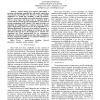Free Online Productivity Tools
i2Speak
i2Symbol
i2OCR
iTex2Img
iWeb2Print
iWeb2Shot
i2Type
iPdf2Split
iPdf2Merge
i2Bopomofo
i2Arabic
i2Style
i2Image
i2PDF
iLatex2Rtf
Sci2ools
ICRA
2005
IEEE
2005
IEEE
Vision Guided Landing of an Autonomous Helicopter in Hazardous Terrain
– Future robotic space missions will employ a precision soft-landing capability that will enable exploration of previously inaccessible sites that have strong scientific significance. To enable this capability, a fully autonomous onboard system that identifies and avoids hazardous features such as steep slopes and large rocks is required. Such a system will also provide greater functionality in unstructured terrain to unmanned aerial vehicles. This paper describes an algorithm for landing hazard avoidance based on images from a single moving camera. The core of the algorithm is an efficient application of structure from motion to generate a dense elevation map of the landing area. Hazards are then detected in this map and a safe landing site is selected. The algorithm has been implemented on an autonomous helicopter testbed and demonstrated four times resulting in the first autonomous landing of an unmanned helicopter in unknown and hazardous terrain.
Autonomous Landing | ICRA 2005 | Precision Soft-landing Capability | Robotics | Unmanned Aerial Vehicles |
| Added | 25 Jun 2010 |
| Updated | 25 Jun 2010 |
| Type | Conference |
| Year | 2005 |
| Where | ICRA |
| Authors | Andrew Edie Johnson, James F. Montgomery, Larry Matthies |
Comments (0)

